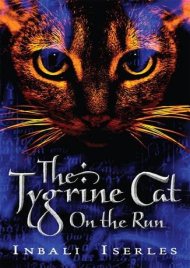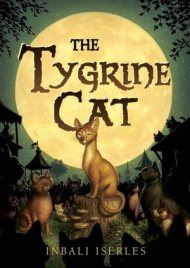Review: 'The Tygrine Cat' and 'The Tygrine Cat on the Run', by Inbali Iserles

 These two Young Adult talking-cat fantasies are recommended for readers age 10 “and up”. Yes, they are up to our age level and Furry interest.
These two Young Adult talking-cat fantasies are recommended for readers age 10 “and up”. Yes, they are up to our age level and Furry interest.
“The Tygrine Cat”; Cambridge, MA, Candlewick Press, April 2008, hardcover $15.99 ([vii +] 242 pages); map by David Atkinson.
“The Tygrine Cat on the Run”; London, Walker Books, January 2011, paperback $5.62 (286 [+ 1] pages).
The Tygrine Cat
As The Tygrine Cat opens, the catling Mati is disembarking from a tramp freighter somewhere in England. He barely remembers being put aboard weeks earlier as a newborn kitten by his mother:
He recalled his mother’s words: ‘Where the ship draws to land, there you must leave it. Until then, stay safe and don’t let yourself be seen.’
‘And what then, Amma, what then?’
‘Then, my son, you will be truly alone, free to follow your senses, to carve out a new life in a very different world. Let the three pillars be your guide.’ (p. 4)
Mati treks upstream from the harbor and meets English riverside cats, who mutter that he is “strange … different … weird … a freak”. Most do not want him in their kin (a group of feral cats), but the friendly black-&-white Domino speaks up for him.
As has become traditional in talking-cat fantasies, there is a feline vocabulary:
‘Now, tell me, Mati, have you ever ‘owned’?’
Mati understood that Sparrow was referring to the strange but ancient custom of cohabitation between feline and human, whereby a feline lived alongside an educated human, a ‘hind,’ and came to ‘own’ them, in a manner of speaking. The ‘owner’ would offer comfort and protection to the human, who in return would provide regular food and stable lodging, a practice cats referred to as ‘socage.’ Mati seemed to remember something about such arrangements but had never himself granted socage. ‘I don’t think I’ve ever ‘owned,’ sir. I don’t dislike hinds, but I can’t remember ever having had to look after one.’ (pgs. 32-33)
The novel alternates episodes telling of young Mati establishing a new life for himself among the English river canal cats, and of Mithos the Destroyer, the agent of his ancestral enemy on the Nile Delta, setting out to find and kill him.
Mithos crept through the shaft for several tail lengths until he reached a low vestibule. Here he left the modern world behind; wordlessly he slipped into the Suzerain’s secret palace. The palace beyond the ventilator shaft had stayed the same for thousands of years, years that had seen the collapse of the ancient city of Bubastis and the rise of Zagazig, now a noisy metropolis. The palace remained, resisting the fast-changing world that clamored against its walls. Around it, buildings had been built and destroyed, electricity pylons had been erected, empires rose and fell. Yet none of this affected the palace or its occupants. (p. 19)
In the Olden Times, thousands of years ago, the Tygrine and the Sa ruled all catdom together. The Tygrine from the Abyssinian deserts, prima inter pares, established the policy that cats and humans would live together, with the cats allowing the humans to believe that they led the partnership. Humanity believes that the pure lines of both breeds became extinct 9,000 years ago when they blended into domestic cats, but the rulers of the purebloods have continued to exist in secrecy. But the Sa of the Nile Delta gradually came to seek open dominance, both among cats and humans:
‘Do you understand what this means? [the Suzerain asks Mithos.] We have almost succeeded in realizing our noble purpose. All cats will be liberated from the shackles of human influence and placed under the Sa’s command. The army of the Sa Mau will soon be ready to march beyond the borders of my empire, to declare one law across the earth. The Tygrine could ruin everything!’ howled the Suzerain. He breathed deeply, and when he spoke again his voice was soft, almost as though he was speaking to a child. ‘Son of Mith, you will hunt down this sedicia, this heir to the Tygrine throne. My spies have told of his escape. By the powers of Sa, you must find him.’ (p. 21)
Mati is permitted to join the Cats of Cressida Lock on a trial basis. As he associates with them, more strangenesses become evident than just his slimness, his pointed ears, and his russet fur with a golden M over an upside-down V head-marking (see Peter Ferguson’s attractive cover painting). He doesn’t mind swimming. He can understand the speech of hinds.
Jess started to wash herself. ‘It’s really amazing, Mati. Before you ran to the fishmonger’s stall, only moments before, your eyes seemed to light up. It was as if they were glowing! I’ve never seen anything like it in my life.’ She licked her paw. (p. 62)
Mithos and the Suzerain seem to have supernatural powers:
Where he [Mythos] passed, thousands of starlings dozing in the high branches of cypress trees took to the air, stirring the heavens with the beating of their wings. Babies awoke, screaming before their bewildered parents. Windows edged free of their catches, flying open to let in a moist wind like stolen breath. (p. 51)
The Suzerain spies on Mati at very long distance through a storm cloud of bluebottle flies shaped like a monstrous cat’s head. Yet it doesn’t take more than a couple of these for the reader to realize that, although they are very dramatic and portentious, they never accomplish much. The cat’s head of flies frightens a robin to death, which the Cressida Lock cats blame on Mati, but this seems to be an unintended outcome; and if the Suzerain has that much mystic power, he ought to be able to arrange something more deadly to Mati.
Since the reader can guess that Mati is destined to not only survive but to triumph, there is not much real suspense. We read because Iserles makes the details so interesting on his way to his ultimate victory. What are Mati’s own Tygrine supernatural powers? Will he discover them in time to save both himself and his new friends? Which of Mati’s new friends will prove true and which will betray him? Mati ventures into the spirit world of Fiåney, “where only the ever-shifting borders of dreams mark the way”, to request guidance from a ghostly oracle. When does an oracle ever give straight advice?
The Tygrine Cat on the Run
The Tygrine Cat seems to end successfully, but there is a sequel. In The Tygrine Cat on the Run, Mati is physically happily settled in his new home, the market-place at Cressida Lock. Astrally, his spirit is on guard for any danger.
His body is in the waking world but his spirit is lost in Fiåney, the magical realm between wakefulness and sleep. (p. 13)
He becomes aware that the Suzerain of the Sa Mau is preparing a new assault.
The Sa embodied cat’s killer instinct, the Tygrine her playful spirit. Armed with Fiåney’s mysterious powers, the ruthless Sa sought to crush the Tygrine, and condemn all cats to darkness. (p. 9)
But is this hazy dream-wake a vision of a present danger, or a memory of one of the Suzerain’s past attacks? Mati is worried enough to advise the Cressida Cats to leave their home for a safer refuge. The Cats argue; Pangur, the leader, supports Mati, but Binjax, a young tom who was preparing to challenge Pangur for leadership anyway, champions those who wish to stay. Meanwhile, the reader learns in an alternating chapter that, not only is the Cat Lord preparing a deadlier attack than before, he recklessly plans to unleash the full weird powers of the Fiåney against the Tygrine cat and his new followers – despite the desperate warning of his old tutor that if the Three spirits of Fiåney are set free, every cat on earth may perish!
Mati, despondent at being responsible for dividing the Cressida Cats, follows Pangur and the loyal cats into the wilderness. He is also uneasy about fleeing without any goal.
‘So we keep moving, in order to escape whatever it is that is following you, or following us,’ said Trillion. ‘But where do we stop? We need a territory, we need land – a cat is not nomadic. We were not meant to wander for ever.’ (p. 86)
After an attack by giant hawks sent by the Three spirits of Fiåney, Mati silently agrees. He resolves to concentrate the menace upon himself, going astrally where his enemy will never expect him: into Fiåney itself.
The last half of the novel alternately follows Mati’s astral self into Fiåney, and follows his physical self with the remaining Cressida Cats as they search for a new home. Mati’s mother had told him to always trust in the three pillars of cat: instinct, judgment, and spirit. But did she mean in three vague philosophical principles, or did they have some supernatural reality? Mati learns that Fiåney has three Gates, each representing one of the three pillars. The friendly spirits Bayo and Etheleldra teach him that the pillars are more than mere words; they represent the three lands of the Harakar, “a place of chaos and flame”, of Sienta, the ancient land of his ancestors, and of Ra’ha, the world of memory where his fallen friends remain, which lie beyond the Borderlands into Fiåney … it is all very mystical, but Mati has no choice: he must enter Fiåney!
As before, there seems to be a definite conclusion. Yet the Epilogue is vague enough that there could easily be another sequel.
Practically every reviewer of these two books has cited the two similar Varjak Paw novels by S. F. Said. Yes. If you enjoyed Varjak Paw (2003), you will enjoy The Tygrine Cat, and vice versa. Another similarity is that S. F. Said was born in Lebanon and raised in London from childhood, and Inbali Iserles was born in nearby Israel and raised in London from childhood. The tone of the books is decidedly British:
‘Well then, kits, I suppose you had all better come inside for kippers.’ (The Tygrine Cat, p. 29)
Availability
Walker Books is the world’s leading independent publisher of children’s books and is part of a vibrant international group that includes Candlewick Press in America, and Walker Books Australia. (press release)
For some reason The Tygrine Cat was published in hardcover by their American Candlewick Press division, but the sequel is only available as a British Walker paperback. Fortunately, it is easy to order from Amazon.co.uk. The Tygrine Cat won the Calderdale Children’s Book of the Year award in 2008 (voted on by school students of Calderdale borough, West Yorkshire).
The series appears to be a popular topic for fan animations, including this officially-sponsored trailer for “The Tygrine Cat on the Run”.
About the author
Fred Patten — read stories — contact (login required)a retired former librarian from North Hollywood, California, interested in general anthropomorphics
Comments
'The Tygrine Cat' and 'The Tygrine Cat on the Run' both are looking really intetresting stories as I read a few about these through this article. I would love to read about them in details for sure.
Post new comment